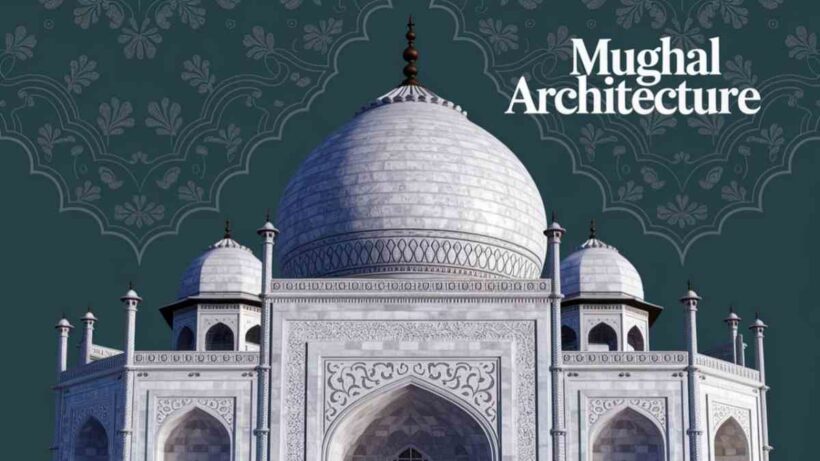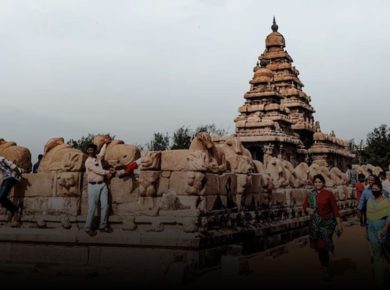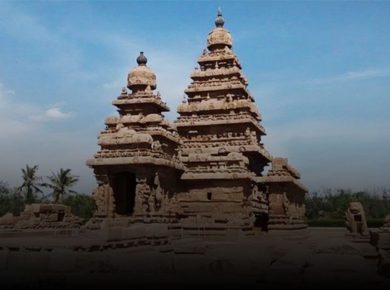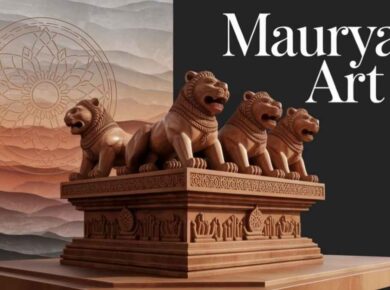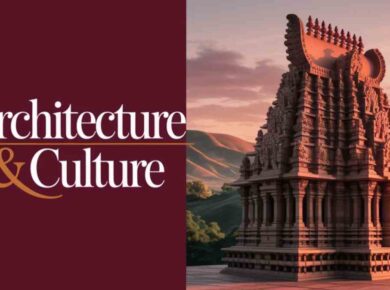Mughal Architecture
Indo-Muslim architecture got striking improvement with the arrival of Mughals, as had been declined significantly during the Lodi’s period. Unlike Delhi Sultanate Sultans, Mughals mixed and mingled with the local population & Rajput provinces. Akbar followed the policy of conciliation to live in peace with his Hindu subjects. He founded Din-i-illahi religion collecting good points of all prevailing religions
Jahangir was half Hindu by blood, his mother, Jodhabai, being a Rajput princess. Shahjahan too continued this policy of tolerance and respect for the Hindus. The Mughal empire, as well as Mughal architecture, flourished and rose to great heights under their benign rule, but all this ended abruptly under the last of the great Mughals, Aurangzeb, a puritanical Muslim, who tried to reverse the entire conciliatory policy of his ancestors.
- He looked upon art, music, dance, painting and even architecture as an evil born of worldly desire
- There was an abrupt decline and eventual downfall in aesthetic appreciation and architectural enterprise.
Babar
- Babar, the founder of the Mughal Empire, was a man of culture and exceptional aesthetic taste.
- For 4 years he ruled in India most of his time was spent in war.
- However, he was fond of formal gardens and a couple of gardens are ascribed to him.
- Ascribed to him are mosque of Kabuli Bagh at Panipat and Jami Masjid at Sambhal nearDelhi
Humayun & Sur interregnum
After Babar’s death, his son, Humayun, succeeded him but he was driven out of India by Sher Shah Suri and after taking asylum in Iran, he eventually returned and overthrew Sher Shah Suri, and regained his throne.
Sher Shah’s own tomb (mausoleum), at Sasaram, in Bihar
- Was made by modifying Lodi octagonal pattern with a verandah around it
- Each side pierced by arches and the halls surmounted by a large and wide dome.
- Surs made use of red and dark grey stone latticed screens, decorative turrets, painted ceilings and colored tiles
- The Purana Qila and the Quila Kohna Masjid inside, are also ascribed to Sher Shah Suri.
- Completed 6th historical city of Delhi called the Shergarh or Dilli Sher Shai around the Purana Qila area in 1540s
Humayun Tomb
- The first distinct example of proper Mughal architecture is the tomb of Humayun, in Delhi, built by his widow, Begha Begum.
- Provided the prototype for Mausoleum of Jahangir at Shahdara, Lahore
- Known as precursor of Taj Mahal, Agra
- Although Sikander Lodi’s tomb as the first garden tomb built in India, it is Humayun’s tomb which strikes a new note.
- The tomb proper stands in the centre of a square garden, raised on a vast platform
- Garden is divided into 4 main parts by causeways (Charbagh), in the centre of which ran shallow water-channels.
- The square, red, sandstone, double storeyed structure of the mausoleum rises over a high square terrace, raised over a series of cells.
- The octagonal form of the central chamber containing the cenotaph is inspired by Syrian and earlier Islamic models.
- First time that red sandstone was used along with white → the white is used cleverly to emphasise, surround & underline doors and windows, strengthening the design.
- The mausoleum is a synthesis of Persian architecture and Indian traditions, in the arched alcoves, corridors and a high double dome as well as the kiosks (chhatris) which give it a pyramidal shape from a distance.
Akbar
Akbar’s made Agra his seat of power. His architecture reflects a blend of the Hindu and Islamic creation.
Agra Fort
- Made of red sand-stone
- On the banks of the river Yamuna
- Begun in 1565 and completed in 1574
The city of Fatehpur Sikri was founded as a token of gratitude to Sheikh Salim Chisti who had foretold that Akbar would have three sons who would survive after the sad demise of many children in infancy.
- Fatehpur Sikri was begun in 1569 and completed in 1574, the same year in which the fort at Agra was completed.
- Fatehpur Sikri was a town planned as an administrative unit consisting of public buildings as well as private residence in close proximity.
- The city is a modest township, consisting of halls, palaces, offices, gardens, pleasure-resorts, baths, mosques, & tombs
- Almost all the structures are based on trabeate construction
- Prominent Structures → Buland Darwaza, Panch Mahal, Dargah of Saleem Chisti, Diwan-i-Khas, Diwan-i-Am, Jodha Bai Palace, Jama Masjid, Ibadat Khana
Panch Mahal
- The highest and the most impressive structure, called the palace of five stories with open terraces on each story
- Based on the Hindu system of trabeate structure, consisting of pillared verandas, architrave, and brackets
- Build on the pattern of a Buddhist Vihara is the topmost domed pavilion, purposefully thrown out of the centre that crowns the entire building.
- The tower was perhaps used for recreation by the emperor and members of the royal household.
Diwan-i-Khas
- A complex structure, also known as Hall of Private Audience
- It is a square chamber with three openings on each side and a richly carved column in the center supporting a magnificent flower shaped capital.
- Thorough ventilation is provided by placing on all sides perforated windows opposite each other on every wall.
- The charming balcony supported by a circular top capital, runs round the halls whole length of the four sides on the first-floor level, supported by brackets.
- It is believed that the central place was occupied by the Emperor’s throne while his Ministers sat at the corners or on the peripheral passage.
Jahangir
- Ascribed with Shalimar Bagh on the banks of Dal Lake in Kashmir
- Built Akbar’s Tomb at Sikandra near Agra, which was completed in 1613.
- Jahangir’s Tomb at Shadera near Lahore, built by his wife Nur Mahal
Shahjaha
- Erected the most romantic building, Taj Mahal, the tomb of his beloved wife, Mumtaz Mahal
- Tajmahal is a square tomb built on a raised terrace, with graceful tall minarets at its four comers.
- As in Humayun’s tomb, the tomb chamber is octagonal, with subsidiary chambers at the angles
- The tomb is surmounted by a graceful double dome & made of white marble (Substitution of red sandstone)
- There is profuse carving and beautiful inlay work with precious multicolour stones (Pietra dura style) in its floral and arabesque pattern,
- Inscriptions in black marble, delicate traceries and trellis work are executed superbly against the background of white marble.
- Shahjaha also constructed a number of elegant, lavishly decorated buildings viz. Khas Mahal, Diwan-i-Khas, Moti Masjid, & Jama Masjid in Delhi
- Built Jami Masjid at Agra in 1648 in honour of his daughter Jahanara Begum & Wazir Khan’s mosque in Lahore, 1634
Red Fort (Lal Quila)
In 1638 Shahjahan shifted his capital from Agra to Delhi and laid the foundation of Shahjanabad, the Seventh City of Delhi, containing his famous citadel, the Red-Fort, which was begun in 1639 and completed after 9 years.
- Red Fort is an irregular octagon with its walls, gates, and a few other structures constructed in red sandstone, and marble used for the palaces.
- It consists of a Diwan-i-Am, containing the marble canopy ornamented with beautiful panels of pietra dura work showing a few paintings.
Diwan-i-Khas (In Red Fort)
- It is a high ornamented pillared hall, with a flat ceiling supported on engraved arches.
- Its pillars contain pietra dura ornamentation and the upper portion was originally gilded and painted.
- It is also said that its marble dais once supported the famous Peacock Throne.
- Consists of the exquisite marble screen containing a representation of the scales of justice
- Walls of this marble palace is ascribed with the famous couplet claiming that “If there be a paradise on earth it is this, it is this, it is this”.
Aurangzeb
- The love of constructing magnificent buildings came to an end rather abruptly with the last of the great Mughals, Emperor Aurangzeb.
- Built Bibi-ki-Maqbara (tomb of his wife Begum Rabia Durani) → a poor replica of the Taj Mahal
